Nokia NRS II Composite Exam Questions and Answers
Select the answer below that correctly lists the 5 different OSPF packet types.
An OSPF router receives an update in which the sequence number, age, and checksum are the same as the entry already in the topological database. What action is taken by the router?
How are LSPs acknowledged on IS-IS broadcast links?
Which of the following types of networks are supported on an Alcatel-Lucent 7750 SR for OSPF? Choose two answers.
What are some of the characteristics of Alcatel-Lucent's implementation of non-stop routing? (Choose two)
What must be configured on the Alcatel-Lucent 7750 SR for RIP to advertise locally attached links?
Which of the statements below best describes the operation of the IPv6 anycast address?
What acts as the tie breaker on an Alcatel-Lucent 7750 SR if the priorities are the same when IS-IS is electing a DIS?
Which of the following conditions will prevent an OSPF adjacency from reaching the full state? Choose three answers.
Which of the following statements best describes an OSPF type 3 LSA?
An OSPF ASBR must have at least one interface in the backbone area (area 0)
Click the exhibit button.
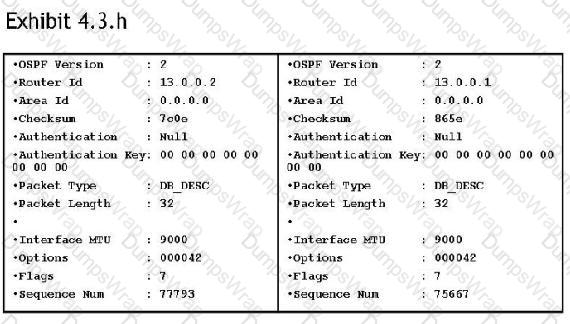
The OSPF packets shown have been exchanged between two neighbors. What state is the OSPF adjacency in?
What is the default inbound metric for RIP on the Alcatel-Lucent 7750 SR?
What value should the AFI be set to for locally administered addressing?
Click the exhibit button.
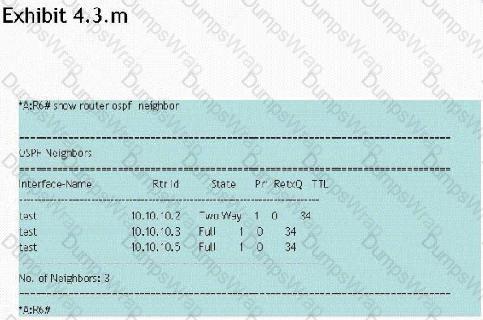
What can you deduce from the show command on router R6?
What is the metric and maximum routable value for RIP?
A router sets the E bit in the flags of its Type 1 LSA. What does this indicate?
When an OSPF adjacency is stuck in the "ExchStart" state, what is the most likely cause?
What command allows analysis of the Dijkstra calculation on the Alcatel-Lucent 7750 SR?
What is the source IP address in an OSPF update?
Refer to the exhibit below. IS-IS IPv6 routing is configured in the network with globally routed addresses as shown. How many routes will R4 have in its IPv6 route table?
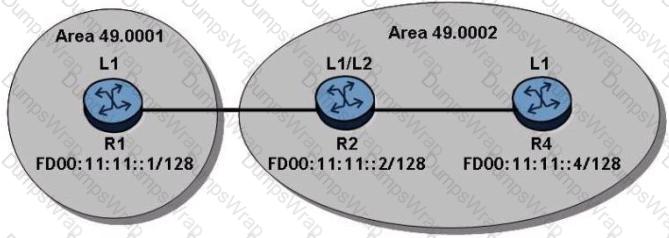
Click the exhibit button.
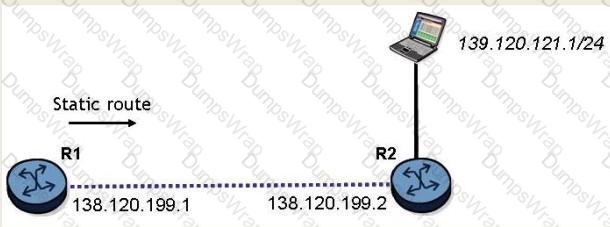
What is the command to configure a static route on the 7750 service router R1 to reach the network behind router R2?
When a router receives an IP packet, but does not find a match in the routing table for the destination IP address, what actions are performed by the router?
Click the exhibit button.
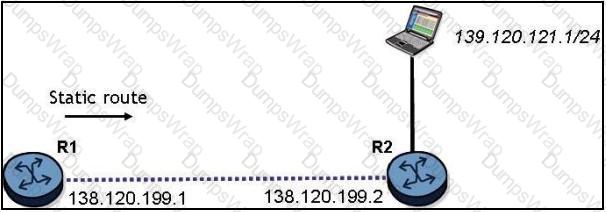
What is the command to configure a static route on the Alcatel-Lucent 7750 SR router R1 to reach the network behind router R2?
What is the default priority value used for electing the DR on an Alcatel-Lucent 7750 SR running OSPF on an Ethernet?
Click the exhibit button.
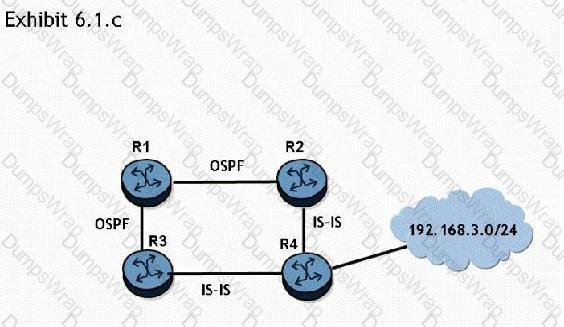
If router R2 redistributes the IS-IS route to 192.168.3.0/24 into OSPF, router R3 preference of these two routes? Choose two answers.
When configuring a filter, where should the most explicit entries be placed?
Click the exhibit button.
Which of the following statements best describes the format of data traffic sent from the PC to the server?
If two routers running IS-IS protocols are exchanging Hello packets with different authentication types, which of the following statements regarding the adjacency state established between them is true?
Click the exhibit button.
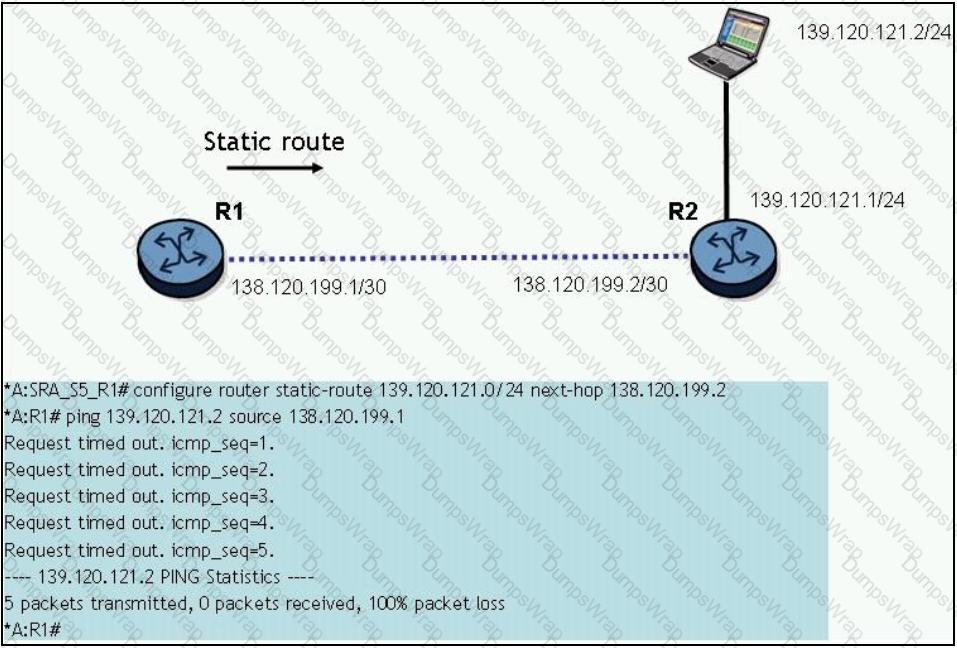
A static route has been configured on router R1 to reach the PC at 139.120.121.2. However, as shown in the exhibit, the ping fails. What is the most likely cause of the problem?
A default route for a client is also known as the:
What command could be used to verify proper configuration of a static route in an Alcatel-Lucent 7750 SR router?
Click on the exhibit.
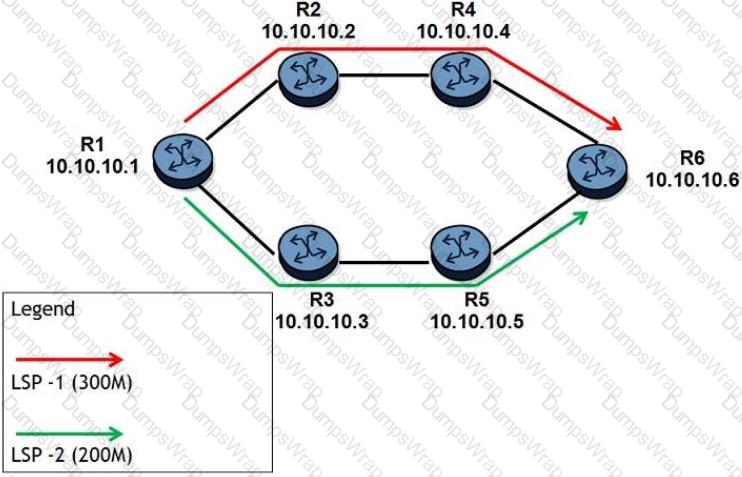
Initially, all links along the path R1-R2-R4-R6 have 400Mbps unreserved bandwidth and all links along the path R1-R3-R5-R6 have 800Mbps unreserved bandwidth. Shared Explicit reservation style is used and Make-Before-Break is enabled. Both fully loose LSPs have been signaled as shown. Later, the configured bandwidth for LSP-1 is changed to 400Mbps. Which of the following is TRUE?
Facility fast reroute with node protection is enabled for an LSP, which of the following is FALSE?
Which of the following best completes the sentence: "An Internet Enhanced Service is a_____________ service where the CE communicates with a ________________interface to send and receive traffic.
Epipe services do no consume any MAC resources because MAC learning is disabled.
What is the purpose of a T-LDP session?
Which of the following describes how a router sets the destination IP address for an RSVP RESV message?
Which of the following statements are TRUE about configuring a distributed Epipe service? (Choose 2)
A technician sitting in a Network Operations Center would like to set up a remote mirror on an Alcatel-Lucent 7750 Service Router to examine some data traffic ingressing a port at a remote site. Which of the following are required? (Choose 2)
Click on the exhibit.
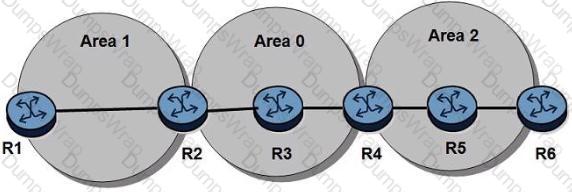
An LDP-over-RSVP tunnel is established between routers R1 and R6. There is a VPN service running between routers R1 and R6. Which of the following is TRUE?
Which LSA type is used for OSPF-TE?
Which of the following about the Link LDP discovery process on the Alcatel-Lucent 7750 SR is FALSE?
Which of the following is NOT an advantage of RSVP-TE compared to LDP?
Click on the exhibit.
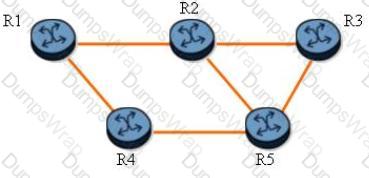
Two LSPs traverse the path R1-R2-R3. Both LSPs are configured with facility fast reroute and link protection. When router R1 is the PLR, which router becomes the Merge Point (MP) for this LSP?
What is a key benefit of a VPLS service?
Which of the following statements are TRUE regarding a fully meshed VPLS service with a default setting? (Choose 3)
Which of the following statements are TRUE regarding sdp-ping? (Choose 3)
Which of the following SAPs will forward all tagged and untagged frames on the port? (Choose 2)
Click on the exhibit.
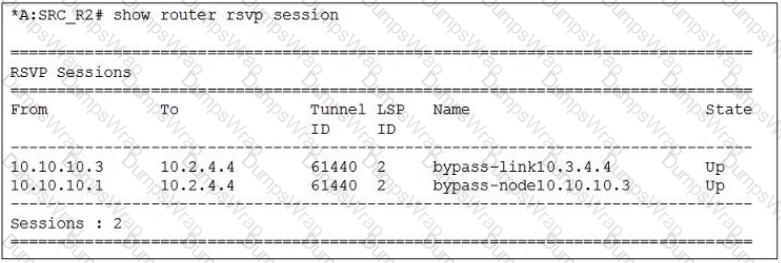
Which of the following about the bypass tunnel is FALSE?
Which of the following steps is mandatory when enabling an MP-BGP session between PE routers in a VPRN?
Which of the following options are used to configure an MPLS signaling type to be used on an SDP? (Choose 2)
Which of the following best describes how the path-mlu is chosen for an SDP?
What are the two major differences between configuring an IES service and configuring VPWS or VPLS services? (Choose 2)
What distinguishes a VPLS service from a VPWS service?
What is the default vc-type for an SDP on the Alcatel-Lucent 7750 SR?
Click on the exhibit.
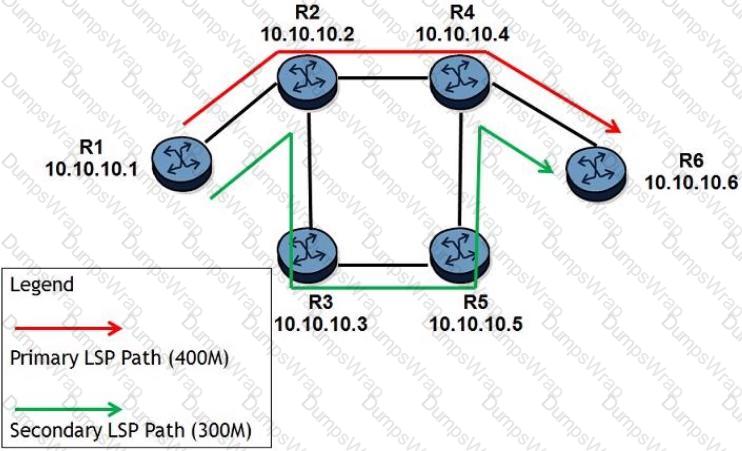
All links have 1Gbps unreserved bandwidth initially and Shared Explicit reservation style is used. After the LSP's primary and standby secondary paths are signaled, how much unreserved bandwidth is left on the links?
When a physical port is configured for null encapsulation, many SAPs can be configured using that port.
In a Layer 2 encapsulation, using Martini, what does the first (top) label represent?
What can the sdp-ping command be used for? (Choose 2)
Which of the following devices assumes the active role during the establishment of an LDP session?
The terms "customer" and "service" are used synonymously when describing a service implementation on the Alcatel-Lucent 7750 SR.
Which of the following about Type 10 opaque LSAs is TRUE?
Which of the following about per-interface label space is TRUE?
Which of the following regarding IS-IS DIS is FALSE?
Click on the exhibit button below.
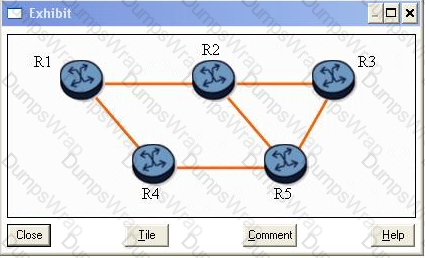
Assuming that LSP R1-R2-R3 requests the default fast reroute configuration, which router becomes a DMP for the detour tunnels?
Click on the exhibit.
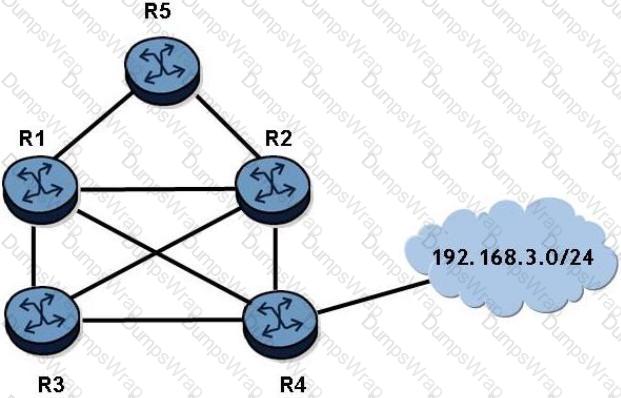
OSPF is operational on all links in the network diagram, all links are the same cost, and all routers are configured with an ECMP value of 4. Router R4 advertises the prefix 192.168.3.0/24 into OSPF.
How many entries for prefix 192.168.3.0/24 will be in router R5's routing table?
What MPLS function should be performed by a router that receives a data packet containing an MPLS label value of 3?
Click on the exhibit button below:
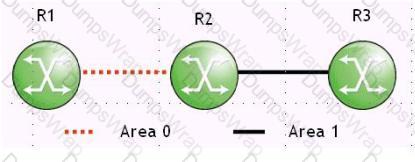
Consider the following:
- Router R2 is an ABR in OSPF Areas 0 and 1.
- Router R2 advertises the aggregate prefix 10.10.10.0/24 into Area 1.
- Router R1 in Area 0 generates LDP labels for FECs 10.10.102/31 and 10.10.10.4/31
Router R3 in Area 1 places these FECs in its LIB, but it does not place them in its LFIB. What can you do on router R3 to make it populate these labels in its LFIB?

A service provider is deploying a 6over4 tunnel to connect a customer's branch office IPv6 network to the corporate headquarters as shown in the exhibit. Which command is used to create a default route on PE2 for the branch office network?
True or False? MPLS may use an existing data link layer header field to identify a label, instead of using a specific MPLS header
Which part of the NSAP address is used to indicate to the end system that a packet is to be processed by the router itself?
Which of the following are top level TLV types defined for OSPF-TE? Choose two answers.
Which of the following best describes the forwarding of a IPv6 packet that has a destination anycast address?
Which OSPFv3 LSA type is similar in function to the OSPFv2 Type 4 LSA?
Click on the exhibit button below. Assume the following:
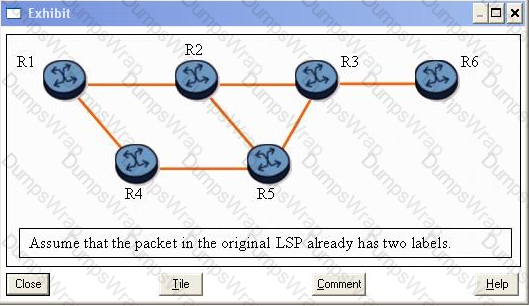
- The protected path is R1-R2-R3-R6.
- Fast reroute one-to-one protection is enabled.
If the original LSP already has two labels, and router R2 has failed, how many labels will there be in packets on the detour path?
Which of the following concerning OSPFv3 is TRUE?
Click on the exhibit.
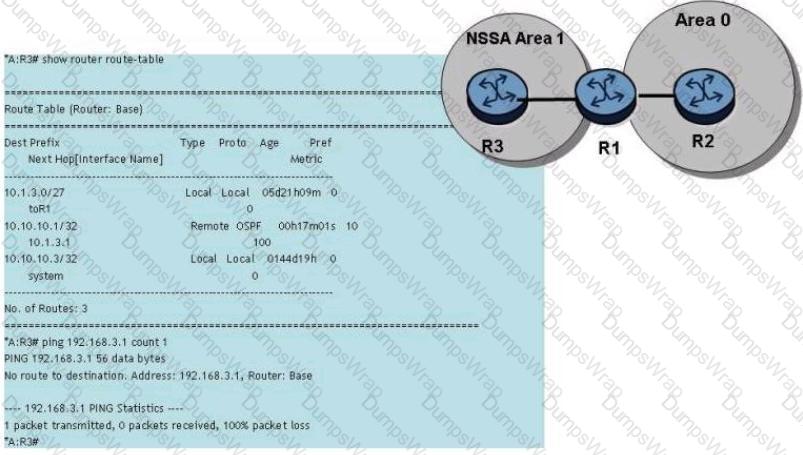
192.168.3.1 is a loopback interface on router R2 and is distributed to OSPF area 0, but the ping fails from router R3.
Which of the following is a possible solution to the problem?
The destination IP address of a received unlabeled packet is successfully matched in the FIB.
Which of the following is FALSE?
Click on the exhibit.
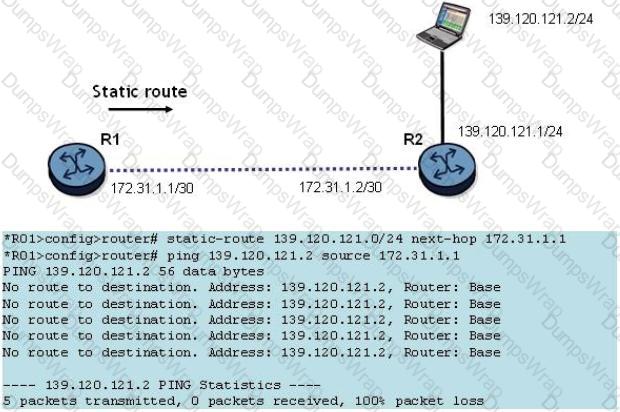
A static route has been configured on router R1 to reach the PC at 139.120.121.2. What might be causing the ping to fail?
Click on the exhibit.
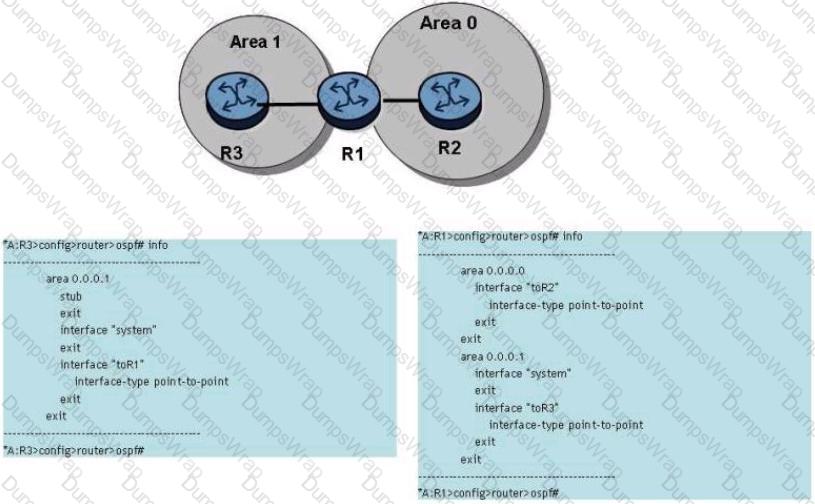
The OSPF adjacency between routers R1 and R3 does not come up.
Which of the following is a possible solution to the problem?
Click on the exhibit button below.
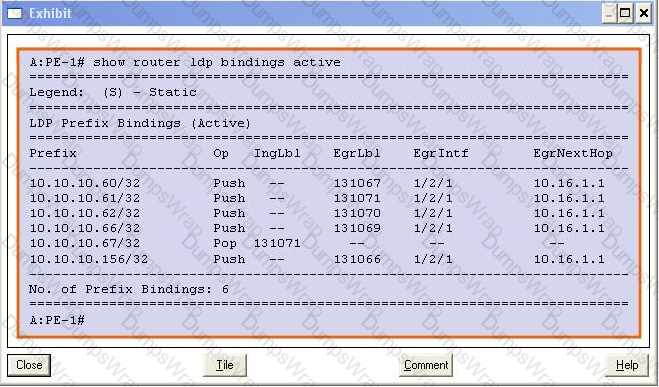
Consider the output shown; what table is displayed?
Which of the following statements regarding OSPF routing updates on a point-to-point link is true?
Which of the following commands may only be used on the head end router to verify the status of an LSP named "LSP 1"? (Choose two)
Which of the following is described by the following statement? An LSR propagates a label mapping only for a FEC for which it has a label mapping for the FEC next-hop.
Click on the exhibit button below.
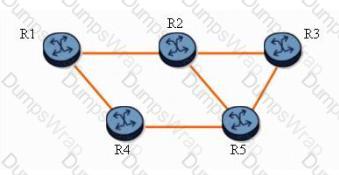
Given the following fast reroute protected LSPs:
-LSP1.R1-R4-R5-R3
-LSP2.R1-R4-R5-R2
Which routers become bypass tunnel PLRs? Choose two answers
Click on the exhibit.

Assuming point-to-point links, which of the following is TRUE?
To configure 6over4 tunneling, where must indirect static routes be configured?
Click on the exhibit button below.
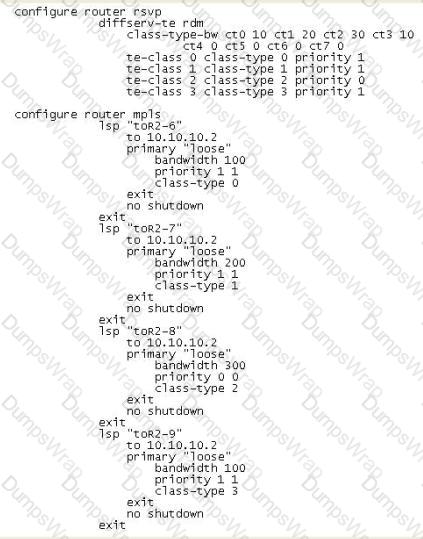
If the four LSPs shown use the shared-explicit reservation style, how much bandwidth does CSPF request across a single 1Gbps link?
Which of the following is a feature of a black-hole static route?
Click on the exhibit.
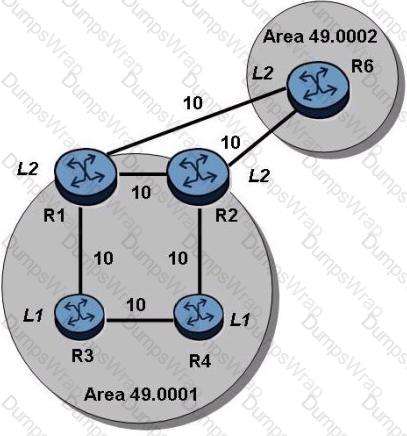
Examine the physical topology of the IS-IS network, the metrics of the links and the levels of the routers. All routers have a system address included in IS-IS.
Which of the following describes the route that router R4 will use to reach the system address of router R6?
A static route needs to be configured with a next-hop that is NOT directly connected to the router. Which of the following must be TRUE?
Click on the exhibit.

Router R2 uses IS-IS to advertise the network 192.168.3.0/24 to R1. How can router R1 discard the route?
Click on the exhibit.
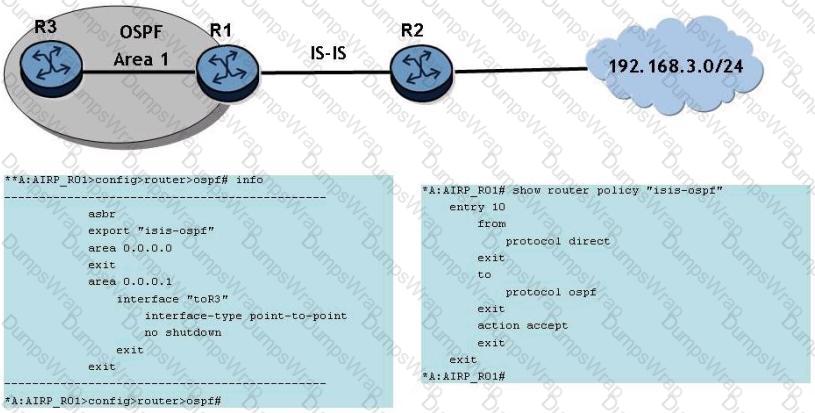
Router R1 learns the network 192.168.3.0/24 from IS-IS. Given the OSPF configuration shown, why isn't the 192.168.3.0/24 route in router R3's route table?
Which of the following are characteristics of an LSP? (Choose two)
Which of the following are functions of the MPLS control plane in a router? (Choose two)
Which of the following best describes an SDP?
Which of the following about the Alcatel-Lucent 7750 SR sdp-ping is TRUE?
Which of the following commands is used to enable an E-pipe service?
What is the best approach of making MTUs match between a VPLS and a spoke IES in order to bring up the service?
A service has a null encapsulated SAP and a vc-type vlan' SDP. What happens when the SAP receives an untagged Ethernet frame?
In a Layer 2 encapsulation using T-LDP, what does the first (top) label represent?
Which of the following about VPRN VRF tables is FALSE?
A CE is connected to an IES interface. Which of the following is TRUE?
Which of the following statements about VPRN is NOT true? (Choose 2)
Which of the following about IES is FALSE?
Which of the following SAPs will forward all tagged and untagged frames on the port?
What is the minimum Ethernet physical network MTU required for a Layer 2 service on an MPLS encapsulated SDP with a service MTU of 1518?
Which of the following about ADSPEC is FALSE?
Which of the following about VPN labels is FALSE?
Which of the following about the components of a service on the Alcatel-Lucent 7750 SR is FALSE?
Click the exhibit.
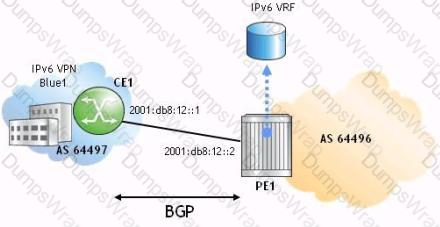
Part of a 6VPE deployment is shown in this exhibit. Which of the following is the correct configuration and context on PE1 for a BGP peering session with CE1?
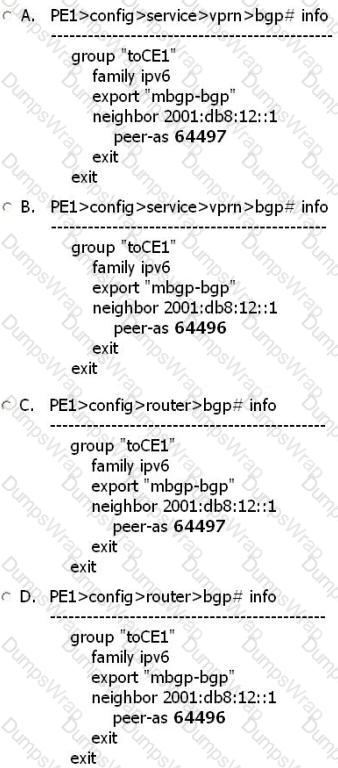
By default, what does the Alcatel-Lucent 7750 SR do when a frame with an unknown destination address is received in a VPLS?
Which of the following best describes how a MAC FDB is populated in a VPLS service?
Which of the following about VPRN VRF tables is FALSE?
Which of the following statements best describes the flooding of traffic on a PE when traffic is received on a mesh SDP?
On an Alcatel-Lucent 7750 SR, which of the following about IES interfaces is FALSE?
Click the exhibit.
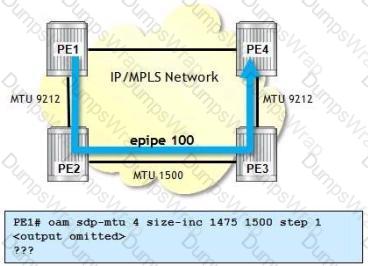
E-pipe 100 is using an SDP (4) with an LSP that uses the path shown (PE1-PE2-PE3-PE4). Which of the following is the expected output from the OAM command?
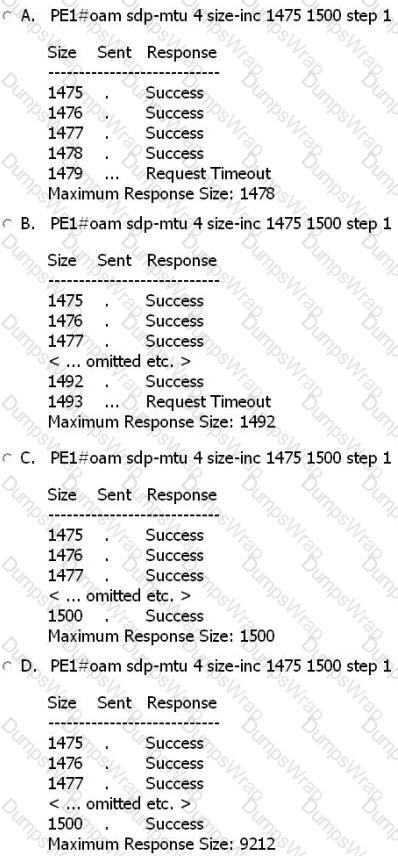
On an Alcatel-Lucent 7750 SR, why must the MTU be explicitly set when configuring an IES spoke termination to a VPLS?
A VPLS receives a frame with the single VLAN tag 35 on the Q-in-Q SAP 1/1/1:35.*. Which of the following describes default Alcatel-Lucent 7750 SR behavior?
Which of the following commands can be used to compare the VC MTU signaled between two PE routers?
Which of the following about IES is FALSE?
Which of the following is a benefit of VPRN as compared to VPLS?
An SDP using MPLS encapsulation is configured for an E-pipe service. The network port on the Alcatel-Lucent 7750 SR used by the SDP has an MTU of 8000. What is the SDP path MTU?
Which of the following about route distinguishes on the Alcatel-Lucent 7750 SR is FALSE?
Which of the following about VPRNs is TRUE?
Which of the following SAPs will toward tagged frames but NOT untagged frames?

